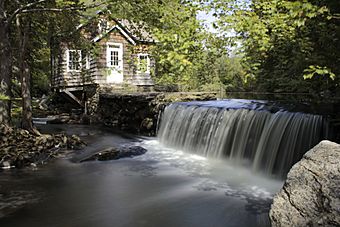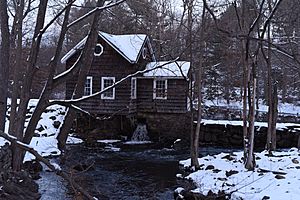Aspetuck, Connecticut facts for kids
Aspetuck is a small village in Fairfield County, Connecticut, United States. It's mostly located in the town of Easton, but also stretches into Weston. The village is named after the Aspetuck Indians, who once lived along the Aspetuck River. In 1670, they sold the land to English settlers.
Aspetuck is famous for its Aspetuck Historic District. This area has many old houses from the 1700s and 1800s that are still well-preserved. It was also the long-time home of Helen Keller, a very inspiring person who was blind and deaf.
Contents
Aspetuck Historic District
Quick facts for kids |
|
|
Aspetuck Historic District
|
|

Dam at the grist mill
|
|
| Location | Roughly, Redding Rd. from jct. with Old Redding Rd. to Welles Hill Rd. and Old Redding Rd. N past Aspetuck R., Towns of Easton and Weston, Connecticut |
|---|---|
| Architectural style | Colonial Revival, Greek Revival, Colonial |
| NRHP reference No. | 91000437 |
| Added to NRHP | August 23, 1991 |
The Aspetuck Historic District is a special area that protects part of the old village. It was added to the National Register of Historic Places in 1991. This means it's recognized as an important historical site.
The district covers about 80 acres (32 hectares) along the Aspetuck River. It includes the oldest part of Easton. There are 22 houses in the district, built between 1750 and 1850. Some of these homes show off styles like Colonial Revival architecture.
Why is it Special?
This historic district is important because it shows what a Connecticut farming community looked like a long time ago. It hasn't changed much over the years. The houses are spread out, often with barns and big yards. These yards were once used for farming, like pastures or gardens. This look reminds us of a time when farming was the main way people made a living here.
The most common type of building is a traditional house with a chimney in the middle and a gable roof. This style was very typical for farming communities in Connecticut in the late 1700s and early 1800s.
Helen Keller's Home
One of the most famous people to live in the district was Helen Keller. She lost her hearing and sight when she was very young. Her amazing journey to overcome these challenges has inspired millions of people around the world.
Helen Keller lived in a house on Redding Road. Even though she couldn't see or hear, she often walked around the neighborhood by herself. She used a fence that went down to the Aspetuck River as her guide. Her home, built in 1946, is a good example of a Colonial Revival style house. It looks like homes from the late 1700s, even though it was built much later.
Important Buildings and Structures
Here are some notable places in the Aspetuck Historic District:
- Orando Perry House (1840): This house shows the influence of Greek Revival architecture. It has a small porch with columns and a triangular roof design.
- Bradley House (7 Old Redding Road)
- Helen Keller House (1946, 163 Redding Road): This house was built to look like older homes from the 1700s.
- Peter Williams House (1810, 65 Redding Road)
- David Bradley House (1790, 135 Redding Road)
- A Bridge (Connecticut Dept. of Transportation Bridge #4933): This concrete bridge was built in 1941. It has stone-faced sides and railings.
- A Dam: This stone dam was built in the mid-1800s. It's located where the Orando Perry grist mill used to be.




